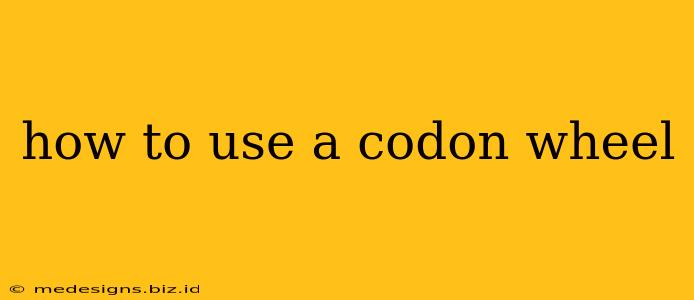Understanding how to use a codon wheel is crucial for anyone studying genetics, molecular biology, or related fields. This handy tool allows you to translate mRNA codons into their corresponding amino acids, a fundamental step in protein synthesis. This guide will walk you through the process step-by-step, making it easy even for complete beginners.
What is a Codon Wheel?
A codon wheel, also known as a codon chart or genetic code wheel, is a visual representation of the genetic code. It's a circular diagram that displays all 64 possible mRNA codons (three-nucleotide sequences) and the amino acid each codon codes for. Understanding how to read this wheel is essential for deciphering the sequence of amino acids that make up a protein.
How to Use a Codon Wheel: A Step-by-Step Guide
Let's break down the process with a simple example. Assume we have the following mRNA sequence: AUG-GGC-UAA.
Step 1: Identify the Codons
The mRNA sequence is divided into three-letter codons: AUG, GGC, and UAA.
Step 2: Locate the First Codon on the Wheel
Most codon wheels are organized with the first base (nucleotide) of the codon in the inner circle, the second base in the middle circle, and the third base in the outer circle. Find the first letter of your codon (A in AUG) in the inner circle.
Step 3: Find the Second Base
Next, follow the line radiating outwards from your first base until you find the second base of the codon (U in AUG) in the middle circle.
Step 4: Find the Third Base
Finally, follow the line from the second base until you reach the third base (G in AUG) in the outer circle. The intersection point will indicate the amino acid coded for by that codon.
Step 5: Determine the Amino Acid
The amino acid encoded by AUG is Methionine (Met). This is also the start codon.
Step 6: Repeat for all Codons
Repeat steps 2-5 for each codon in the mRNA sequence.
- GGC: Following the same method, we find that GGC codes for Glycine (Gly).
- UAA: This is a stop codon, signaling the end of the protein sequence. It does not code for an amino acid.
Understanding Stop Codons
Three codons — UAA, UAG, and UGA — are stop codons. They don't specify an amino acid; instead, they signal the ribosome to terminate protein synthesis.
Different Types of Codon Wheels
While the layout is generally consistent, there might be slight variations in the design and color-coding of different codon wheels. However, the underlying principle of using the three concentric circles to locate the amino acid remains the same. The key is to familiarize yourself with the specific wheel you are using.
Beyond the Basics: Applications of Codon Wheels
Codon wheels are invaluable tools in many areas of molecular biology:
- Protein Synthesis: Understanding how codons translate to amino acids is fundamental to comprehending the process of protein synthesis.
- Gene Sequencing: Codon wheels are used to interpret gene sequences and predict the amino acid sequence of the corresponding protein.
- Genetic Engineering: In genetic engineering, codon wheels are used to design and modify gene sequences.
- Bioinformatics: Bioinformatics uses codon wheels in various analytical applications related to genes and proteins.
Mastering the Codon Wheel
With a little practice, using a codon wheel will become second nature. By understanding the basic principles outlined in this guide, you'll gain a valuable skill for tackling genetic and molecular biology problems. Remember to always double-check your work, and don't hesitate to consult different codon wheels or online resources if you encounter any difficulty.
